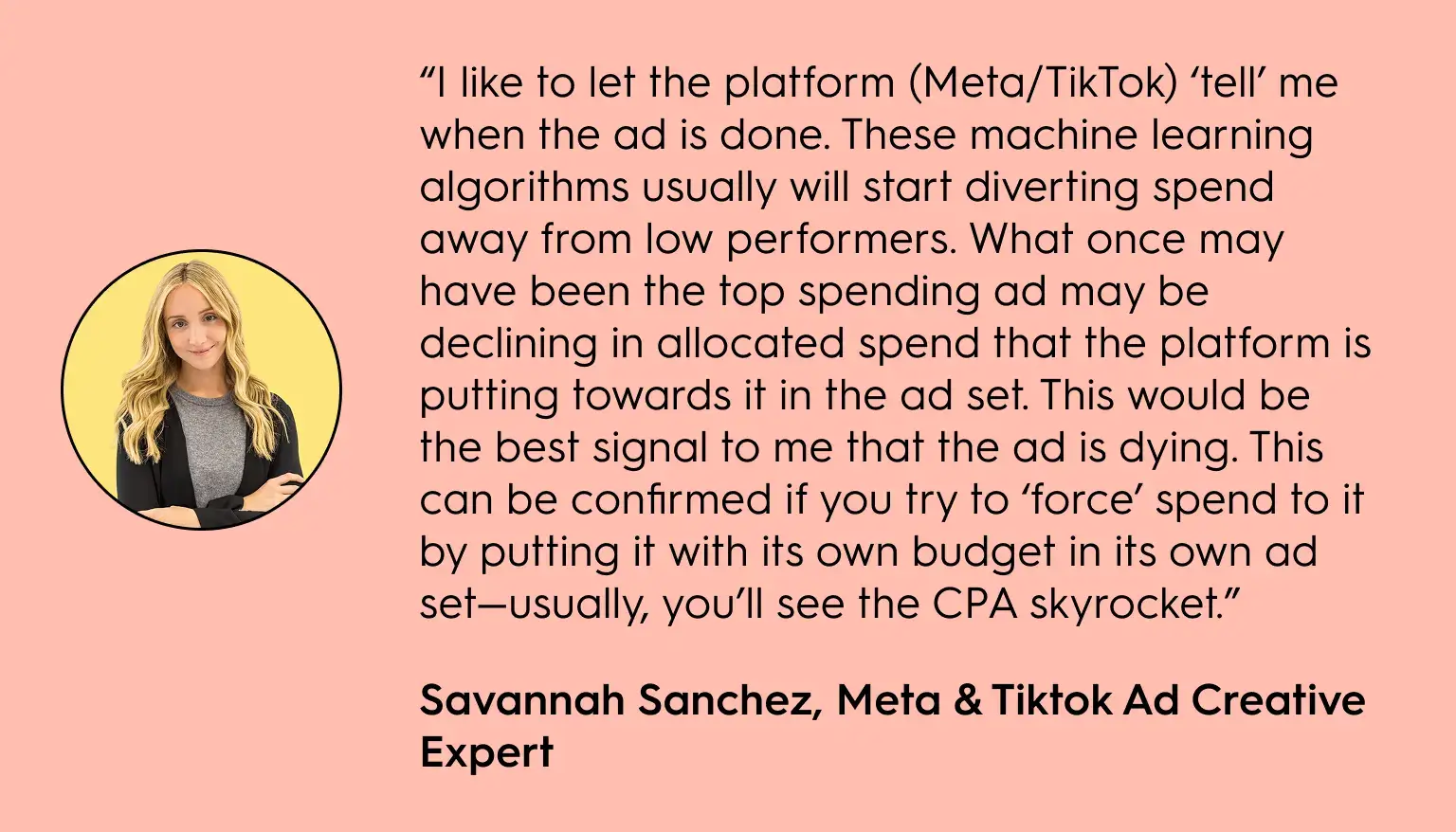How Long Should a Good Ad Last?
.webp)
You don’t always see when ad fatigue sets in. It doesn’t ring a bell or wave a red flag. It just sort of… starts. Quietly. One skipped scroll here. A sudden drop in CTR there. Then comes the moment your daily spend keeps burning—but conversions drop. And you’re not even suspicious yet.
Marketers rarely notice. That’s the problem.
Because unlike milk, which lets you know it's expired with a smell that ruins your whole week, an ad doesn’t tell you it’s rotten. It just sits there… stale, invisible, and $15,000/month expensive.
So how long should a good ad last?
That’s the wrong question. What you should be asking is: how long until it starts repelling the exact people you paid to attract?
And yes, your audience is actively ignoring you. Not because they hate your brand. But because your brain-looping creative has trained their eyes to look the other way.
Let’s fix that before another week slips into “burned budget” chart.
{{form-component}}
The One-Night Stand Theory of Ad Exposure
You love an ad the first time—you click, you react, maybe even remember it. But see it again? Let me guess: you yawn, scroll, maybe even grunt. That’s not you failing. That’s creativity doing what it always does: it fades. Creative fatigue breeds fast, and your brain moves on before the third look.
Every Re‑View Hurts Engagement.
Grounded in grit, here’s what the analytics scream:
- After just 4 repeat views, conversion likelihood plummets by roughly 45%. That’s alarm.
- If someone sees your ad 11+ times, they’re 4.2% less likely to buy than folks who saw it 2–5 times. That isn’t subtle—it’s brutal.
Your campaign might feel unstoppable, but these numbers show the quiet grave you’re digging.
Brain Biology Is Tony-Sized Proof.
Our brains crave novelty. Diminishing engagement isn’t your strategy failing—it’s biology turning your ad into wallpaper. Once your creative hits the “seen it” folder, it’s dead. That’s how to detect ad fatigue, in metrics that bleed before your eyes: CTR drops, ROAS flattens.
Metrics That Betray: What to Watch
This is where fact meets intuition. When those numbers start sliding...
- CTR falls—your click magnet just breaks magnet.
- CPC creeps up—or worse, your ROI caves.
- Frequency hits 4+, meaning viewers are over you—and rewarding your defense with indifference.
Those are the ad fatigue metrics to watch.
When Spending More Actually Makes Your Ads Worse
You think you're winning when your budget climbs? Nope. You might just be training your audience to start ignoring you faster. Overexposed ads underperform and trigger a mental shutdown.
Repetition Triggers the Mental Mute Button
Neuromarketing data shows that a staggering 73% of viewers “switch off” mentally when ads repeat across a single channel, and fatigue jumps by up to 90% when campaigns lack coordination. That's a neurological revolt.
This signals a core truth: spending more on fatigued creative accelerates dismissal. It’s brain-block.
As Jessica Campos from ImpactLine Digital pointed out:
%20(1).webp)
In other words: you might drown in clicks while your actual customer quality is flatlining. That is one hell of an ad fatigue sign—a warning that your campaign is pulling all-nighters, and not in a good way.
When Ad Spend Does the Opposite of Save You
More budget doesn’t buy more results when you’re shoving the same tired creative at the same audience. That’s exhaustion, not efficiency. That's the moment marketing becomes margin-destroying instead of growth-enabling.
If you want to combat ad fatigue, you need to be proactive:
- Rotate your creative before your audience even yawns
- Mix your media, coordinate frequency across platforms
- And yes—watch for those early behavioral signals before they're irreversible
Because the truth is… your money is only as smart as your creative’s staying power. Don’t fund the corpse. Fund what can regenerate.
What Does Ad Fatigue Actually Look Like?
Ad fatigue is the howl when every metric you once trusted turns traitor. Metrics begin to betray you—and if you don’t notice, you’re already losing.
1) CTR Slides by 20%+ — Without Warning
A sudden dip in click-through rate—like 20% below baseline—is ad fatigue waving a blaring siren. It’s not the algorithm playing tricks—it’s your creative slipping into the “meh” zone. That’s the number you can’t ignore. This is the kind of ad fatigue metric you must watch.
2) CPC Starts Climbing—Creative Unchanged
When cost-per-click creeps up while your ad doesn’t change, your creative has become invisible—yet still annoying. That rise is called leaking budget via wasted exposure.
3) ROAS Flatlines, Then Craters
If your return-on-ad-spend flattens then collapses, don’t blame the seasonality. Ad fatigue jumps off the page.
4) Engagement Rot
Fewer likes. Comments evaporate. Shares vanish. That's creative rot—slow, silent, deadly.
5) Frequency >3?
Once your frequency surpasses three impressions per user, they’re done. It’s scientific: that’s your burnout marker.
Build Your Fatigue Dashboard
Don’t wait for collapse. Craft a weekly fatigue dashboard to watch:
- CTR vs CPC gap
- Frequency bounce-back alerts
- Creative decay flags
You're not guessing. You're diagnosing in real-time and combat ad fatigue before it's a financial autopsy.
How Long Should a Good Ad Last? Let’s Actually Answer That.
Look, there’s no universal expiration date for ads—but there are platform‑specific red lines where performance turns toxic.
Meta: The 20% CTR Crash or Frequency 3 Rule
If your CTR drops 20% or more versus the previous 7‑day baseline—or your frequency breaches 3 impressions per user—that’s code red. Audiences have mentally checked out. No more suspense, please. That’s when it’s time for creative rotation.
%20(1)%20(1).webp)
TikTok: Hold Rate Fallout
If your 6‑second hold rate slides 15% or more week‑over‑week, it’s done. TikTok viewers are ruthlessly short‑attentive. That’s catastrophic. Replace the creative before it rots your results.
LinkedIn: Engagement Crater & CPL Spike
When your engagement rate collapses and Cost Per Lead pops 25% upward, you’re not just tired—you’re extinct. LinkedIn doesn’t forgive overstay. It punishes.
YouTube (Shorts or In‑Stream): Vanity View‑Through Slip
Falling into the below‑25th‑percentile view‑through tier? That means your content just got backgrounded. Even if the sound’s off, that metric dying is your cue to swap creative stat.
Why These Are Thresholds
Ad fatigue isn’t about days. It’s the gap between what you promised and how long your audience pretended to care. When those platform‑specific metrics crumble, you’re not looking at lag—you’re witnessing burnout.
These thresholds are like mental stop signs for creative violence. If you respect them, you prevent decay. If you don’t—well, your ad will tell you by tanking the rest of your funnel.
Why Your Audience Hates You (And It’s Your Fault)
No, they didn’t ghost you. You trained them to flinch every time your brand shows up.
Overexposure doesn’t just cause boredom—it breeds contempt. According to a CM Group study, 61% of consumers unsubscribed from three or more brands in just three months because of—you guessed it—repetitive marketing messages. Not irrelevant ones. Not poorly timed ones. Just... the same old, same old.
This isn’t about ad fatigue in social media. It’s bigger than that. This is creative fatigue’s final form—relevance entropy.
Your ads didn’t offend anyone. They exhausted them. You went from “interesting” to “expected” to “invisible” in the span of four campaign cycles. Not because your product got worse. But because your creative didn’t evolve. You turned your own brand into background noise.
{{cta-component}}
The Brain Has a Mute Button—and You Helped It Push It
Repetition without relevance becomes mental spam. The human brain is hardwired to deprioritize repeated stimuli. It’s not personal—it’s neural efficiency. Once someone’s seen your ad a few times, their dopamine response drops. Their attention stops paying attention.
This is the exact moment where ad fatigue vs creative fatigue becomes a distinction that matters. Ad fatigue is what happens on the media side. Creative fatigue is what causes it.
You’re not building brand familiarity—you’re stockpiling brand resentment. And that’s a rotten trade. Because once someone associates you with “useless interruption,” you can’t frequency-cap your way back into their trust. Not with lookalike targeting. Not with retargeting. Not even with a bigger budget.
If your brand tone doesn’t shift, your conversion rate will. And it won’t be going up.
How to Build Ads That Last Longer (But Not Too Long)
If your media strategy still treats creative like a set-it-and-sweat-it operation, you’re stalling.
Let’s get this out of the way fast: you don’t want ads that last “long.” You want ads that last just until they don’t. The goal isn’t longevity—it’s staying fresh until flatline. Anything after that? You’re not marketing anymore. You’re apologizing with paid impressions.
One Ad Is Not a Strategy. It’s a Delay Tactic.
Marketers still cling to the fantasy that one clever hook and a catchy line of body copy will float for weeks. It won’t. Not on Meta. Not on TikTok. And definitely not on LinkedIn where relevance has the shelf life of pre-cut avocado.
You want ads that rotate—not repeat.
You want frequency caps that protect—not suppress.
You want messages that sequence—not linger.
Why? Because creative fatigue is a performance leak. You’re not “saving budget” by running fewer assets. You’re actually burning more of it—just slower and more quietly.
%20(1).webp)
Stop Building Monoliths. Start Building Playlists.
Here’s the least dramatic way to prevent ad fatigue: don’t make one ad. Make five. Launch with three. Schedule a refresh cycle with the other two. Let no asset outlive its usefulness. Use ZoomSphere’s Workflow Manager to preload briefings, refresh flags, and rotation milestones before the first dollar is spent.
Every good campaign needs a setlist. Not a single track on loop.
And yes—frequency cap best practices matter. But not if your creative doesn’t give your audience a reason to care the second time around.
Rotate hooks. Keep the value prop tight. And above all: don’t try to stretch one hit into a brand strategy. That’s lazy.
Want longer ad lifespan? Treat your ads like software. Ship updates. Or expect bugs.
Rotten Ad? Here’s the Checklist Before You Pull the Plug
You don’t need a sixth sense to know when your ad’s expired. You just need to stop pretending it’s “still collecting data.”
It’s not.
It’s decomposing in public.
Most marketers wait for their ROAS to trip over its own shoelaces before reacting. By then, the damage’s already halfway to your Q3 report. What you need is an actual system—a checklist—to help detect ad fatigue before the body goes cold.
Let’s break it down.
CTR just dropped off a cliff?
If your click-through rate nosedives 20%+ below your 7-day baseline, you're not “under-segmented.” You're underperforming. Pull up your creative variants and test a fresh hook. Not a fresh color palette. A fresh promise.
Ad frequency just hit 3+?
Three. That's your ceiling. Not your goal. Anything past that, and you’re actively annoying people. Best practice is cap frequency per audience segment and rotate in a new visual or fresh copy, not a minor tweak. Repetition isn't reinforcement—it’s erosion.
CPC climbing while CTR dives?
That's the creative alignment death spiral. If you’re paying more to get ignored faster, it’s not a media problem. It's a message mismatch. Pause the ad. Reassess the offer-message-asset trio. Don’t “optimize.” Overhaul.
And if you think your platform isn’t already on to you? Savannah Sanchez of The Social Savannah says otherwise:

Now, that’s system-level performance throttling—your ad being ghosted by the algorithm. And it means your asset isn't just underperforming… it's being actively deprioritized.
Comments slowing to a crawl?
That’s the silent rejection. Not dramatic. Not angry. Just pure apathy. Recheck your engagement windows. And yeah—consider if the ad was even conversation-worthy to begin with. If it wasn’t, it doesn’t belong in social media. That’s just noise-polluting your own feed.
ROAS plateaued?
No, your lookalike audience didn’t “shift.” Your offer ran out of people who cared. Welcome to targeting fatigue. Swap out creative or reset the audience, preferably both. Because the longer you wait, the harder it’ll be to climb back.
You’re not launching ads to “see what happens.” You’re launching to win. That means testing early, rotating faster, and never assuming performance today means relevance tomorrow. Especially in ad fatigue-heavy social platforms, where attention spans die young.
{{form-component}}
Your Ad Is Dying. Slowly. Publicly. Repeatedly.
Ad fatigue doesn’t announce itself. It doesn’t ask for permission. It creeps in the backdoor and eats your margins while you’re busy refreshing your ROAS dashboard, hoping numbers will magically turn around. But they won’t. They can’t. Because you’re still running the same dehydrated ad creative you launched 98 days ago thinking it had “legs.”
It didn’t. It had knees made of crackers.
No, it’s not your platform’s algorithm. It’s not your audience’s fault. And no—it’s not your media buyer burning your budget. Your ad is just tired. And expired.
The terrifying bit is… you’ll usually only notice after the damage is done. After the clicks flatline, after the CPC starts climbing like it’s training for Everest, and after the conversions decide they’d rather take a nap.
Don’t build ads that need CPR. Build creative that swaps itself out before it starts reeking. ZoomSphere lets you see the moment your campaign starts bleeding performance. Not later. Not “let’s give it a few more days.” Now.
The milk’s turning. Pull it. Replace it. Or keep paying to pour it.












Heading 1
Heading 2
Heading 3
Heading 4
Heading 5
Heading 6
Lorem ipsum dolor sit amet, consectetur adipiscing elit, sed do eiusmod tempor incididunt ut labore et dolore magna aliqua. Ut enim ad minim veniam, quis nostrud exercitation ullamco laboris nisi ut aliquip ex ea commodo consequat. Duis aute irure dolor in reprehenderit in voluptate velit esse cillum dolore eu fugiat nulla pariatur.
Block quote
Ordered list

- Item 1
- Item 2
- Item 3
Unordered list
- Item A
- Item B
- Item C
Bold text
Emphasis
Superscript
Subscript



.webp)


%20(2).webp)
%20(1).webp)
%20(1).webp)

